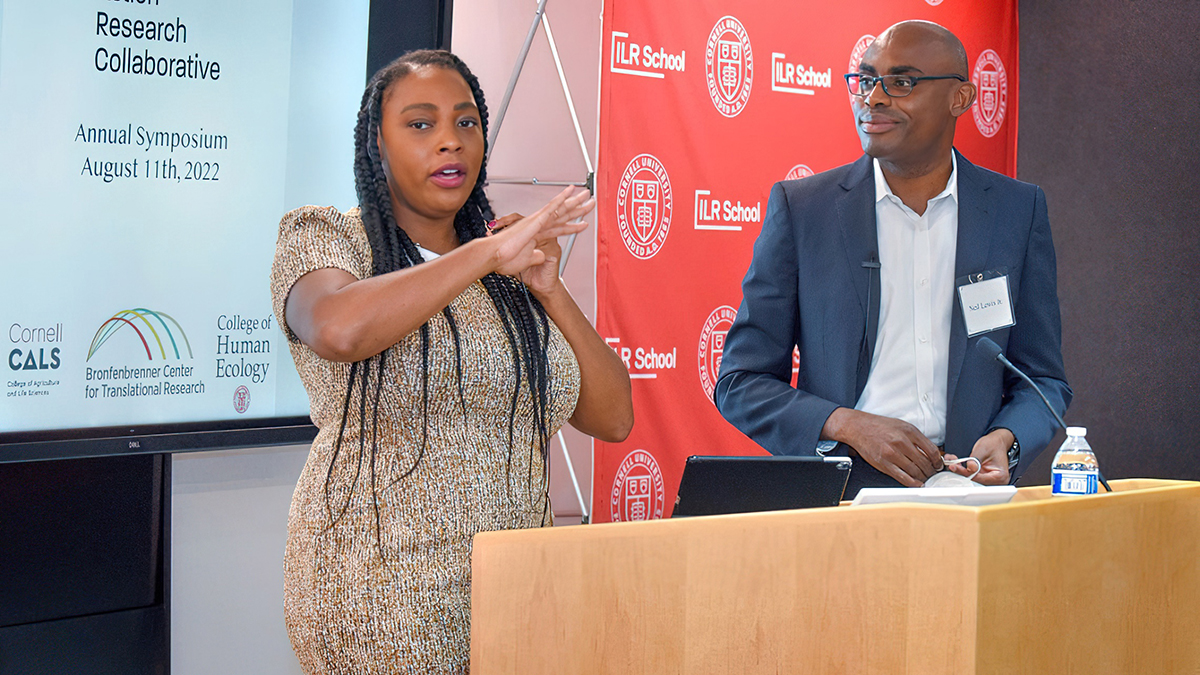Members of Cornell’s Action Research Collaborative joined representatives from New York City agencies at a symposium Aug. 11 to discuss innovative new solutions aimed at dismantling the systemic racism that has led to inequities around food and nutrition, education, health and employment.
The symposium highlighted research-community partnerships that take an inclusive approach, comprising community members and organizations, lawmakers and researchers.
“Working in silos has proven to be ineffective at addressing pressing issues impacting historically marginalized communities,” said Tashara M. Leak, assistant professor in the Division of Nutritional Sciences and co-director of the Action Research Collaborative (ARC), which is part of the Bronfenbrenner Center for Translational Research in the College of Human Ecology. “The mission of ARC is to facilitate these collaborations, and leverage the expertise and resources to move the needle on these issues.”
To conquer health inequities, conversations with the communities are a must, said Julian Watkins, health equity specialist with the New York City Department of Health and Mental Hygiene, especially around topics like systemic racism and its health consequences.
“We’re shifting away from old patterns that no longer serve us and never really served us,” Watkins said.
“We really need community voices from the early onset to make sure we’re not failing them,” said Roger Figueroa, assistant professor in Cornell’s Division of Nutritional Sciences.
Each community is unique, and solutions need to be tailored for it. Courtney McCluney, assistant professor of organizational behavior in the School of Industrial and Labor Relations, realized this while studying how Detroit was creating an entrepreneurial ecosystem.
“I realized that my academic knowledge was not useful there. None of our theories were driven and centered on the lives of people in Detroit,” McCluney said. “So that’s where I found community partners to be useful. They helped me figure out how I can leverage access to my institution to help these community-based organizers do their work better.”
Just as communities are unique, so are their schools. Brian Bereman, borough director of Restorative Justice Programs for the New York City Department of Education, helps implement disciplinary programs where those involved in conflict talk about what happened and what can be done to make things right. Bereman said each of the city’s 181 schools needs an individualized approach, and that makes listening to teachers and administrators essential.
“Some schools do things differently, and that doesn’t make it wrong, it just means there’s a different entry point for each,” he said. “The needs of a school in Pelham are very different than Soundview, which is very different from Fordham, which is very different from Riverdale.”
The Community Neuroscience Initiative (CNI), an ARC partner, is taking a novel path toward education equity, working with Syracuse, New York schools to help students understand how the brain works and learns, and understanding how health, trauma and nutrition affect a child’s education. At first, CNI did its work in classrooms, but as its reach has grown, the initiative has taken a different approach.
“We can’t go to every single school, so we teach all the pre-service teachers (student teachers) about neuroscience principles and then have the pre-service teacher work with their mentor to adapt how those principles are taught to a particular classroom,” said Eve DeRosa, associate professor of psychology and co-director of the Syracuse Brain Hub, part of CNI. She added that the work being done in Syracuse is applicable to education equity in New York City.
The lessons gleaned from the symposium provide a roadmap for ARC’s work in the city, said Neil Lewis Jr., ARC co-director and assistant professor of communication and social behavior in the College of Agriculture and Life Sciences.
“These are not issues that any one person, discipline or agency can address. They require deep collaborations and partnerships between researchers across disciplines, policymakers and governments and, most importantly, with people who are on the ground working in the community – with the communities – to address these issues,” he said. “That’s why the Action Research Collaborative was set up.”
By Juan Vazquez-Leddon
Bronfenbrenner Center for Translational Research
Juan Vazquez-Leddon is communications director for the Bronfenbrenner Center for Translational Research





